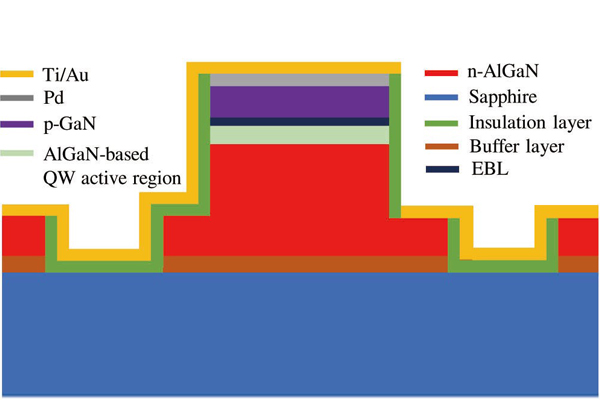1 Gbps free-space deep ultraviolet communications based on micro-LEDs
Deep Ultraviolet (UV) light with wavelengths below 300 nm is widely used for many different kinds of applications as these short wavelengths can trigger chemical reactions and excite fluorescence in materials. This makes deep UV extremely useful for label tracking, optical sensors, disinfection and decontamination of surfaces and water, curing materials and forensic or drug detection. These applications have driven the development of compact and efficient AlGaN-based deep UV light emitting diodes (LEDs). Another intriguing application is deep UV free-space optical communications, the potential of which has been known for some time, as the properties of light at these short wavelengths can enable unique embodiments of this technology. For example, as most of solar deep UV radiation is absorbed by the ozone layer in Earth's stratosphere, deep UV provides the opportunity to establish high-security free-space optical communication links between satellites in the upper atmosphere where the atmosphere "shields" the communication links from attempts at eavesdropping. Furthermore, since deep UV is strongly scattered in air, a low background noise non-line-of-sight (NLOS) optical communication link with low pointing, acquisition and tracking requirements can be constructed using deep UV light sources on the ground. As a result, it is possible to build a multi-access NLOS optical communication link by using deep UV transmitters. While deep UV communication links have been reported, their performance has been severely limited by the low efficiency and/or modulation bandwidth of the light sources, being either flash tubes, lamps or conventional deep UV LEDs. Therefore, developing deep UV light sources with high modulation bandwidth is of paramount importance.
In recent years, micro-LEDs (μLEDs) have been developed as novel transmitters for visible light based free-space optical communications. These μLEDs, which have lateral dimensions of less than 100 μm, have extremely high modulation bandwidths (in excess of 800 MHz has been reported) which is enabled by their small feature size, which in turn supports very high wireless data transmission rates. It is well known that the modulation bandwidth of LEDs is determined by two factors, namely the resistance-capacitance (RC) time constant and the differential carrier lifetime. For conventional LEDs, the modulation bandwidth is mainly dominated by a large RC time constant due to the large area of the LEDs. As a result, the modulation bandwidth of conventional LEDs is relatively low, typically on the order of 10 MHz. However, in contrast, the modulation bandwidth of μLEDs is mainly dominated by their differential carrier lifetime, thanks to their small area. This carrier lifetime is the average time for electrical charge carriers take to recombine inside the µLED's active region and emit light. The shorter the lifetime, the more rapidly the µLED's optical output can respond to a fast electrical signal and therefore the higher the device's modulation bandwidth. The small feature size of μLEDs allows them to be driven at very high current densities which, since the carrier lifetime generally decreases at higher current densities, means that the modulation bandwidth of μLEDs can be an order of magnitude higher than that of conventional LEDs. These novel characteristics make μLEDs strong transmitter candidates for high-speed free-space optical communications. For example, a data transmission rate over 10 Gbps at a free-space transmission distance of 5 m was recently demonstrated using a series-biased μLED as a transmitter in a visible light free-space optical communication system. It is expected that the µLED device format can also be used to achieve high modulation bandwidths at deep UV wavelengths.
The researchers from the Institute of Photonics, University of Strathclyde and Li-Fi R&D Centre, University of Edinburgh have investigated the modulation characteristics of μLEDs emitting in the UV-C region (200-280 nm) and their applications as light sources in deep UV free-space optical communications. The research results are published in Photonics Research, Volume 7, No. 7, 2019 (X. He, et al., 1 Gbps free-space deep-ultraviolet communications based on III-nitride micro-LEDs emitting at 262 nm).
The deep UV μLEDs fabricated in this work present a great improvement in the modulation bandwidth, which is around 3 times higher than the previously reported modulation bandwidths of other UV-C LEDs. Moreover, at low current densities, the measured modulation bandwidth of the deep UV μLEDs is much higher than that of visible μLEDs, which illustrates the huge potential of the deep UV μLEDs for high-speed free-space optical communications. By applying these deep UV μLEDs into a free-space optical communication link, the data transmission rate is significantly increased, which is more than 15 times higher than the previously reported deep UV optical wireless links. Moreover, the measured modulation bandwidths of the deep UV μLEDs and system data transmission rates are limited by the cut-off frequency of the avalanche photodiode (APD) detector used for the measurement. The researchers consider that an even higher modulation bandwidth of the deep UV μLEDs and, in turn, an even higher deep UV data transmission rate will be achieved if a higher modulation bandwidth APD detector can be applied.
This work presented the excellent modulation performance of the deep UV μLEDs. Moreover, the application of these μLEDs in deep UV high-speed free-space optical communications has also been demonstrated. Future work will focus on the further optimizations of the deep UV μLEDs and optical set up in order to fully explore and realize the potential of these deep UV μLED transmitters. Recently, by adjusting the optical set up and using a high modulation bandwidth APD detector, a deep UV data transmission rate over 3 Gbps is achieved at a free-space transmission distance of 1 m. Furthermore, a NLOS communication link based on the deep UV μLEDs will be constructed in the future.

Cross-sectional schematic diagram of a single deep-ultraviolet μLED


